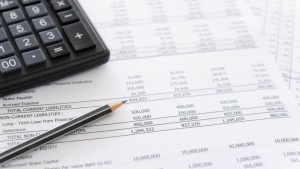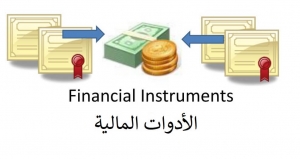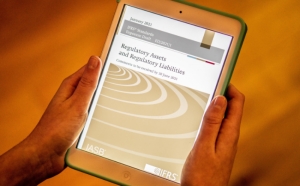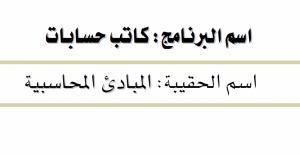عرض العناصر حسب علامة : الالتزامات
"أثر التحوّل إلى المعايير الدولية لإعداد التقارير المالية على الزكاة"..جلسة ضمن أعمال مؤتمر "الزكاة والضريبة والجمارك"
تحدّث عضو هيئة التدريس بقسم المحاسبة في جامعة الفيصل الدكتور هشام البراك عن المعايير الدولية بمفاهيمها وأجزائها وعناصرها الرئيسة متماثلة مع المعايير السعودية، منوهًا أن الفرق بينهما هو شمول المعايير الدولية والتي تُعد أكثر شمولًا تغطي الكثير من الموضوعات وأكثر عمقًا من ناحية الإفصاح ومتطلباتها.
ما الفرق بين قائمة الدخل وقائمة المركز المالي
قائمة المركز المالي balance sheet وقائمة الدخل income statement هي أدوات مالية تستخدم لإدارة الأداء المالي للشركات، حيث تسلط قائمة المركز المالي الضوء على أصولها والتزاماتها وحقوق الملكية والاستثمارات المالية الأخرى في تاريخ محدد من ناحية أخرى، تقدم قائمة الدخل لمحة موجزة عن المعاملات المالية للشركة بما في ذلك الأرباح والخسائر خلال فترة معينة.
معيار المحاسبة المصري رقم 28 المخصصات والالتزامات المحتملة والأصول المحتملة
معيار المحاسبة المصري رقم 40 الأدوات المالية - الافصاحات
كيفية حساب الأصول المتداولة في المحاسبة؟
عندما يتعلق الأمر بعملك، فإن مواكبة أموالك أمر لا بد منه. وللتعرف على وضعك المالي، افهم كيفية حساب بعض الأرقام، مثل الأصول المتداولة.
معلومات إضافية
-
المحتوى بالإنجليزية
How to Calculate Current Assets in Accounting
MARIA TANSKI-PHILLIPS | JAN 27, 2022
When it comes to your business, keeping up with your finances is a must. And to know where you stand financially, understand how to calculate certain figures, like current assets. Get the scoop on how to calculate current assets for your business and how to use them to evaluate your company’s finances.
What are current assets?
Before you can dive into how to find current assets, you need to learn what current assets are. Here’s a brief rundown.
Current assets are items of value your business plans to use or convert to cash within one year and are considered short-term investments. Businesses sell, consume, and utilize these assets during their day-to-day business operations. A few examples of current assets include:
Cash and cash equivalents
Accounts receivable
Inventory
Prepaid expenses
Short-term investments
Marketable securities (e.g., stocks)
Some of your current assets may be considered liquid. Liquid assets are assets that you can quickly turn into cash, like stocks.
Current assets help keep your business operating smoothly. You can use them to pay daily operational expenses and other short-term financial obligations. Not to mention, finding current assets can help you get insight into your business’s cash flow and liquidity.
How to calculate current assets
Once you know what you’re looking for, current assets are simple to calculate. To find current assets for your business, use the current assets formula:
Current Assets = Cash + Cash Equivalents + Inventory + Accounts Receivables + Marketable Securities + Prepaid Expenses + Other Liquid Assets
Yes, calculating current assets is as easy as doing a little addition. As long as you know what your current assets are, you’re golden.
Use your balance sheet to help find the amounts you need to compute total current assets.
The best way to evaluate your current assets is to compare them to your current liabilities. Generally, having more current assets than current liabilities is a positive sign because it shows good short-term liquidity. However, having too many current assets isn’t always a good thing. A “good” amount of current assets can also vary by industry and your business’s goals.
After you compute current assets, you can use your findings to calculate other small business ratios, such as:
Current ratio (Current Assets / Current Liabilities)
Quick ratio = [(Current Assets – Inventory + Prepaid Expenses) / Current Liabilities]
Net working capital = (Current Assets – Current Liabilities)
Want to see how your business stands financially?
Download our FREE whitepaper, Use Financial Statements to Assess the Health of Your Business, to learn about the financial statements you need to gather for your calculations.
Get My Free Guide!
Calculating current assets: Example
Now that you know how to find total current assets, let’s take a look at calculating it in action.
Say your company has the following current assets:
Cash: $6,000
Inventory: $500
Accounts receivable: $1,000
Marketable securities: $2,000
Prepaid expenses: $200
Other liquid assets: $2,000
As a reminder, use the following formula to find your total current assets:
Current Assets = Cash + Cash Equivalents + Inventory + Accounts Receivables + Marketable Securities + Prepaid Expenses + Other Liquid Assets
Current Assets = $6,000 + $500 + $1,000 + $2,000 + $200 + $2,000
Your total current assets for the period are $11,700.
Say your current liabilities equal $8,000. In your case, having more current assets than current liabilities shows that you have a healthy amount of current assets.
how to find current assets
Using current assets
Again, your current assets can tell you a lot about how healthy your business’s finances are. Keep these things in mind when finding and using current assets to assess your financial health:
Current assets only involve assets you can convert to cash within one year, or short-term investments
Average current assets can vary based on your business’s industry and goals
Generally, your business should have a 1:1 or greater ratio of current assets to current liabilities
In many cases, you want current assets to be more than current liabilities, but there is such a thing as having too many current assets
Your current asset ratio should be no more than 2. A ratio over 2 shows that you’re not investing assets enough
Having a healthy balance between current assets and current liabilities can help you when it comes to:
Reaching goals
Applying for business financing
Fundraising
مجلس معايير المحاسبة الدولية (IASB) يقترح معيارًا جديدًا
يقترح مجلس معايير المحاسبة الدولية (IASB) معيارًا جديدًا للمعايير الدولية لإعداد التقارير المالية (IFRS) لمنح المستثمرين صورة أكثر اكتمالاً عن الأداء المالي
معلومات إضافية
-
المحتوى بالإنجليزية
IASB proposes new IFRS Standard to give investors a more complete picture of the financial performance of rate-regulated companies
The International Accounting Standards Board (Board) has today published proposals for a new accounting standard that would require companies subject to rate regulation to give investors better information about their financial performance.
Rate regulation, which is common in some industries, including the utilities and public transport industries, determines the amount a company can charge its customers for goods or services supplied to them and the period when the company can charge that amount.
In some cases, the period when a company supplies goods or services differs from the period when the company can charge customers for those goods or services—and thus differs from the period when the company reports revenue in its income statement.
When those differences in timing occur, the revenue a company reports for a period in its income statement and the assets and liabilities it reports in its balance sheet do not give a complete picture of the amount that the rate regulation entitles the company to charge for goods or services supplied in that period.
Currently, IFRS Standards do not require companies to give investors information about those differences in timing.
The proposed Standard would introduce a requirement for companies to give investors such information by reporting regulatory assets and regulatory liabilities in their balance sheet, and related regulatory income and regulatory expense in their income statement.
This information would complement the information companies already provide applying current IFRS Standards and give investors a more complete picture. The additional information would help investors understand which fluctuations in the relationship between a company’s revenue and expenses are caused by differences in timing and enable investors to make better assessments of the company’s prospects for future cash flows.
Hans Hoogervorst, Chair of the Board, said:
Rate regulation can have a big impact on a company’s revenue and profit, but currently investors don’t get the full picture of this impact. Our proposed new IFRS Standard will require additional information to give investors a more complete picture.
The proposed Standard would replace IFRS 14 Regulatory Deferral Accounts.
Access the Exposure Draft Regulatory Assets and Regulatory Liabilities consultation. The deadline for comments is 30 June 2021.










